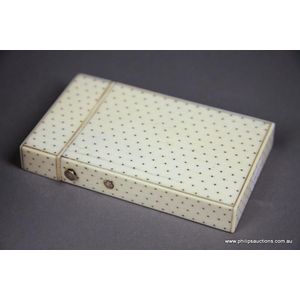Complete Collection of Ten Bamboo Studio Decorative Letter Papers
You must be a subscriber, and be logged in to view price and dealer details.
Subscribe Now to view actual auction price for this item
When you subscribe, you have the option of setting the currency in which to display prices to $Au, $US, $NZ or Stg.
- Embossed / Repousse - Embossing, also known as repousse, is the technique of decorating metal with raised designs, by pressing or beating out the design from the reverse side of the object.It is the opposite of chasing, where the decoration is applied from the front. An embossed or repoussed object may have chasing applied to finish off the design.
- Qing Dynasty - The Qing Dynasty was the last imperial dynasty of China, ruling from 1644 to 1912. It was established by the Manchu people, who originated from the northeastern region of China. The Qing Dynasty was preceded by the Ming Dynasty and followed by the Republic of China.
- Ming Dynasty - The Ming Dynasty was a ruling dynasty of China from 1368 to 1644. It succeeded the Yuan Dynasty and preceded the Qing Dynasty. The Ming Dynasty was established by Zhu Yuanzhang, a former Buddhist monk who became a rebel leader and eventually overthrew the Mongol Yuan Dynasty. During the Ming Dynasty, China experienced a period of relative stability and prosperity. The government was centralized and bureaucratic, with the emperor at the top of the hierarchy. The Ming Dynasty is known for its cultural achievements, including the development of porcelain, the invention of movable type printing, and the construction of the Great Wall of China.
This item has been included into following indexes:
Visually similar items

A set of two Chinese woodblock printed catalogues of Chinese paintings, Published by Rongbao Zhai in 1961, 4 cm x 22.5 cm x 32 cm. Provenance: Switzerland private collection, acquired in the 1979s, NSW private collection, 1961

A Georgian ivory pique card case, early 19th century, of simple rectangular form with a push button release hinged top exquisitely inlaid throughout with a fine pattern of tiny silver dots. Length 9 cm. Width 5 cm

Hermes, pocket square scarf, printed silk, signed within, 45 x 45 cm

A silk pochette by Hermes, the 'Neige d'Antan' design by Cathy Latham on a dusty pink background, 42 cm square, with box
